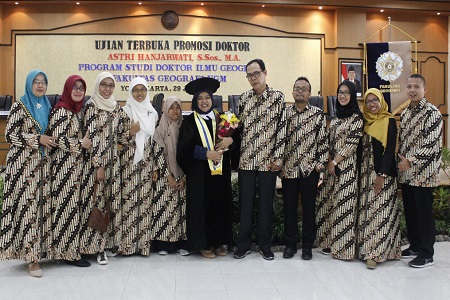Dr. Astri Hanjarwati Earned Doctoral Degree with Very Satisfying Point

The Faculty of Social and Humanity Sciences (FISHum) UIN Sunan Kalijaga has a young doctor lecturer again. On Monday, July 29, 2019, through the open trial session of the Geography Doctoral Promotion, Geography Postgraduate Program, Faculty of Geography UGM, the Sociology lecturer of UIN Sunan Kalijaga, Astri Hanjarwati, S.Sos., M.A. officially holds the title of Doctor.
This Doctoral promotion took place in the Merapi Auditorium Room, Building A, Floor I, Faculty of Geography UGM. Dr. Astri Hanjarwati earned a Doctorate in Geography with her dissertation titled “Resiliensi Penyandang Paraplegia Korban Bencana Gempa Bumi di Kabupaten Bantul Tahun 2006”.
The trial was chaired by Dr. Andri Kurniawan, M.Sc with the promoter Prof. Dr. Muh Aris Marfai, S.Si, M.Sc, and the co-promoters, Mr. Prof. Dr. R. Rijanta, M.Sc, and Dr. M Pramono Hadi, M.Sc. As the panels of examiners in this open session trial were Dr. Sri Rum Giyarsih, M.Si. Ro'fah, MSW, Ph.D., Dr. Agus Joko Pitoyo, M.Sc. and Dr. Suharman, M.Si.
Meanwhile, an appreciation also came from the Dean of The Faculty of Social and Humanity Sciences, Dr. Mochamad Sodik, S.Sos., M.Si. He said that Astri is a Sociology lecturer who exemplifying ideas and actions.
"Congratulations, success, and full of blessings to Mrs. Dr. Astri who earned the Doctorate title at the Faculty of Geography, UGM. Dr. Astri, our new doctor is not only an academic but a humanist activist also. Through her busy schedule in academic and other affairs, Mrs. Astri is active in PLD UIN Suka,” he said when asked after the Doctoral promotion event.
He said that with great dedication and conscientiousness, Dr. Astri tries to bridge several different perspectives on how to treat wisely disabilities people. Dr. Astri Hanjarwati successfully presented and defended her dissertation well and got a very satisfying graduation ceremony.
"Once again, I congratulate you. Dr. Astri is an academic and activist who is eagerly assisting the weak and weakened people by systems and cultures. The dissertation titled ‘Resiliensi Penyandang Paraplegia Korban Bencana Gempa Bumi’ is one of the dedication of Dr. Astri that can integrate various things into one meaningful theme," he added.
In his dissertation, Dr. Astri Hanjarwati researches the resilience of paraplegic people who were victims of the Bantul earthquake in 2006 using a geographic approach. This study focuses on people with paraplegia. The difference and novelty from this research with previous studies are on the research subject, namely new disabilities.
This new disability is the victim of the Bantul earthquake in 2006 who suffered a spinal cord injury and currently, the person endures paraplegia. The research locations are in six sub-districts in DI Yogyakarta with the highest number of people with paraplegia. These sub-districts as research locations include Piyungan, Bambanglipuro, Jetis, Sewon, Pundong, and Pleret.
"The population of people with paraplegia in these six sub-districts is 124 people, and a sample of 44 people was taken using the stratified random sampling method (questionnaire) and in-depth interviews with 10 families. The data analysis methods are quantitative and qualitative from questionnaires, in-depth interviews, observations, and secondary data," written Dr. Astri in her explanation.
The novelty and complement to previous researches are first, being with paraplegia is a risk. This risk is not only determined by threats, vulnerabilities, and capacities, but also by the response. Second, this study confirms that the life-triangle rescue method is proven to save people from death, but the method has a weakness which it is seriously injured in any part of the body.
Third, the resilience in people with paraplegia is achieved through 4 phases; the stress phase, the phase of self-acceptance and adaptation, the phase of self-development / capacity building, and the resilience phase (mobility, productivity, and social relationship). Fourth, the resilience factors of people with paraplegia that are different from the previous research are the accessibility and adaptation factors. Fifth, the adaptation patterns of people with paraplegia are people who depend on their families, people who are independent, and people who are independent and productive.
Sixth, the increased livelihood assets of people with paraplegia were social modal while human modal, physical modal, and financial modal had decreased. Finally, the distribution of houses for people with paraplegia is in very prone and prone areas with the closest average distance, which is 1.02 km and the farthest is 7 km. (tri)
Sumber: http://isoshum.uin-suka.ac.id/id/liputan/detail/249/dr-astri-hanjarwati-raih-gelar-doktor-dengan-nilai-yudisium-sa
